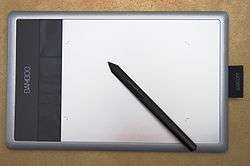Active pen


An active pen (also referred to as active stylus) is an input device that includes electronic components and allows users to write directly onto the LCD screen surface of a computing device such as a smartphone, tablet computer or Ultrabook.[1] The active pen marketplace has long been dominated by N-trig [2] and Wacom,[3] but newer firms Atmel[4] and Synaptics[5] also offer active pen designs.

Active pens are typically used for note taking, on-screen drawing/painting and electronic document annotation, as well as accurate object selection and scrolling.[6] When used in conjunction with handwriting recognition software, also referred to as Optical Character Recognition (OCR), the active pen's handwritten input can be converted to digital text, stored in a digital document, and edited in a text or drawing application.

The active pen's electronic components generate wireless signals that are picked up by a built-in digitizer and transmitted to its dedicated controller, providing data on pen location, pressure and other functionalities. Additional features enabled by the active pen's electronics include palm rejection to prevent unintended touch inputs, and hover, which allows the computer to track the pen's location when it is held near, but not touching the screen.[7] Most active pens feature one or more function buttons (e.g. eraser and right-click) that can be used in place of a mouse or keyboard.

An input device known as a passive stylus can also be used to write directly onto the screen, but it does not include electronics and thus lacks all of the features that are unique for an active pen.[6] The typical passive stylus also has a large tip made of rubber or conductive foam in order to emulate a user's finger, rather than the more accurate ballpoint pen-like tip used in the active pen.
Active pen devices support most modern operating systems, including Google's Android and Microsoft Windows.[8]
See also
References
- ↑ Hughes, Andrew (2011). "Active Pen Input and the Android Input Framework". M.S. thesis. California Polytech State University. p. 2.
- ↑ Cooper, Andrew (September 12, 2013). "N-trig Release Teases that Fujitsu's Stylistic Q702 will Come with Active Pen Support". Engadget.com. Retrieved February 28, 2014.
- ↑ Kendrick, James (September 28, 2004). "Wacom Digitizer for Smartphones". GigaOm.com. Retrieved February 28, 2014.
- ↑ Takahashi, Dean (January 7, 2014). "New Sensors Could Lower the Cost of Touchscreen Pens – and Make Them as Good as Pen and Paper". VentureBeat.com. Retrieved February 28, 2014.
- ↑ Gasior, Geoff (October 17, 2013). "Synaptics Intros Pressure-Sensitive Stylus Tech for Win8.1". techreport.com. Retrieved February 28, 2014.
- 1 2 Linenberger, Michael (October 16, 2013). "The Importance of an Active Digitizer Pen". MichaelLinenberger.com. Retrieved January 6, 2014.
- ↑ Bricklin, Dan (2009). Bricklin on Technology. Indianapolis, IN: Wiley Publishing. p. 283. ISBN 978-0-470-40237-5.
- ↑ "Android Getting Native Active Pen Support in Ice Cream Sandwich". GottaBeMobile.com. Notebooks.com Inc. October 21, 2011. Retrieved January 6, 2014.